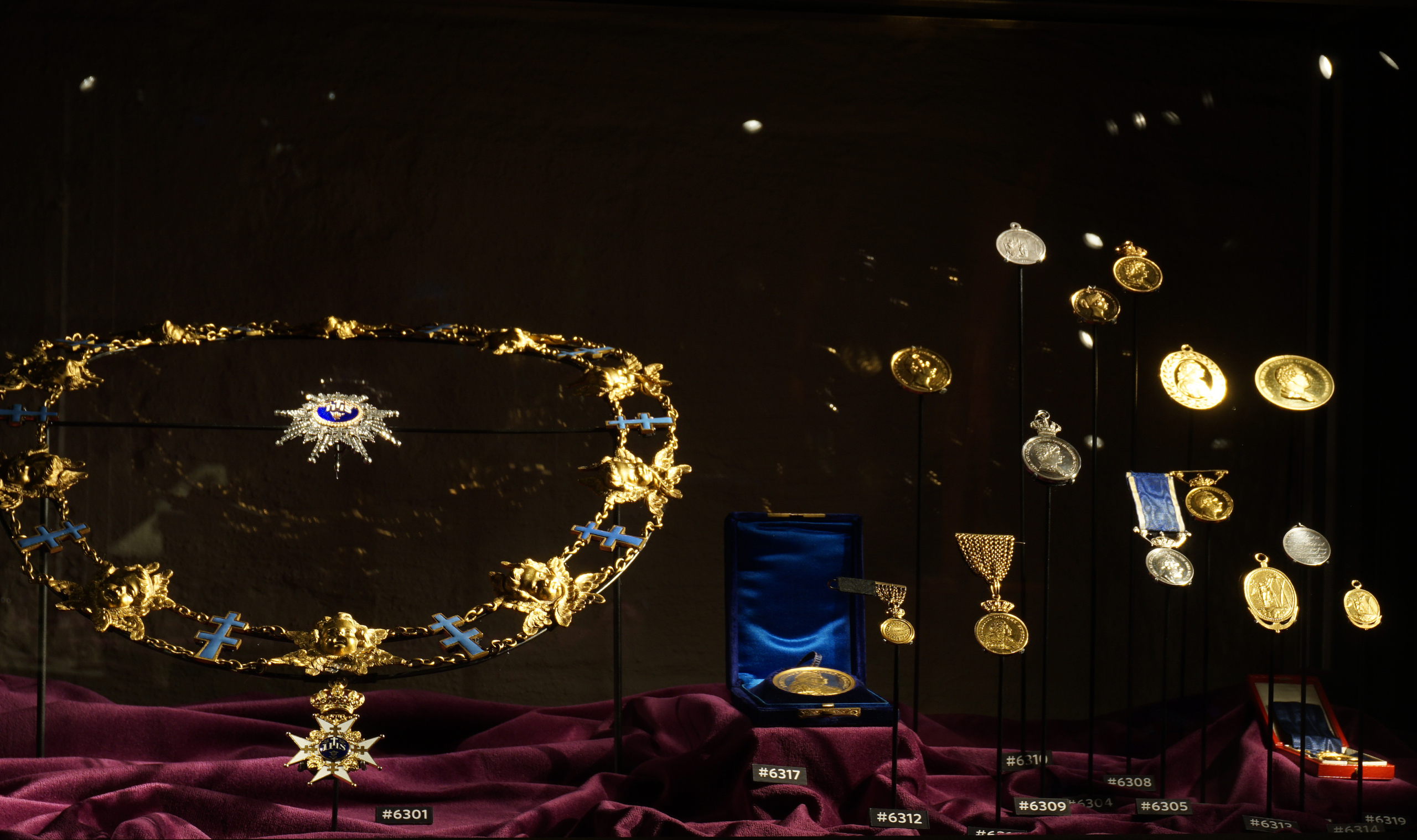
Following a major fire in Gothenburg in 1821, Gustaf Melin received the gold medal of honour of the board of directors of the General fire insurance company (Allmänna brandförsäkringsdirektionen) for having saved a number of lives. Melin was a ship’s chandler, that is, a retail dealer who sold supplies and equipment to ships. It was unusual for someone with an ordinary job to receive a medal.
One side of the medal features the portrait of King Karl XIV Johan (Charles XIV John) of Sweden and the other side has the inscription “For Civic Zeal”. Known as the Fire of Stigberget, the fire injured Melin’s legs so badly that he never recovered. He died in 1828 at the age of 50.
Certain symbolic objects can raise a person’s status. Medals and orders are official distinctions awarded by a country’s head of state as a public reward. Sometimes recipients will decline them, perhaps because they believe people should not be categorised by status or for other political reasons. Or because they think they do not need any reward.
Symbolic value can mean a great deal to the people involved. The objects represent something immaterial of great value. This might be a sense of fellowship within a religion, a country or a movement, but also an event, a belief or certain values.
Typical examples are the Christian cross, the Islamic crescent moon, national flags or the rainbow flag. Other symbols are the scarves and shirts worn by sports fans to show which team they support.
Sometimes people are prepared to use force if someone does not respect a symbolic value. In other cases people do everything possible to provoke reactions by disrespecting this kind of value.
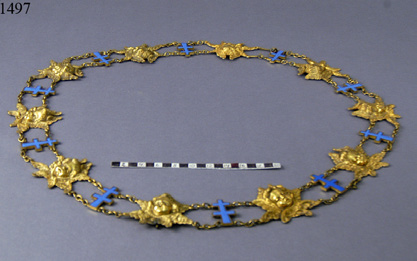
6301
Collar of the
Royal Order of
the Seraphim
A collar with blue crosses interspersed with gold angels. Gold angels were also called seraphim. The collar belongs to the Royal Order of the Seraphim. It was made sometime between 1845 and 1860 and is 133 cm long. It weighs 780 grams and is made of gold, enamel and brass.

6302
Breast star
A breast star is the badge of an order of merit that is attached directly to the wearer’s clothing. It is 7.9 cm in diameter and made of gold and silver. It has eight points and a blue enamel globe in the middle with the text “IHS”, which means Jesus.
This breast star is said to have been worn by count Henning Hamilton. He was knighted and made a government minister in 1858. He received the star in 1871. After 10 years he was not permitted to keep his orders of merit due to a forgery scandal. He was also forced to leave Sweden.
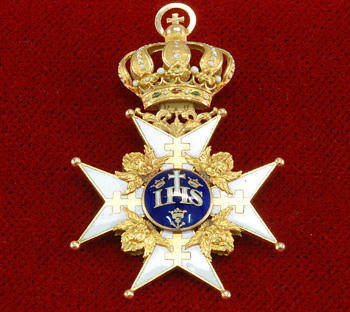
6303
Badge of a Knight
of the Royal Order
of the Seraphim
The badge of a Knight of the Royal Order of the Seraphim shown here is from about 1859. The order is 5.4 cm wide and made of gold and enamel. It looks like a star with four white rays that each divide into two points. On each ray is a cross. In the centre is a blue globe with the text “IHS”, which means Jesus. At the top is a gold crown.
This badge is said to have been worn by count Henning Hamilton. He was knighted and made a government minister in 1858. After 1881 he was not permitted to keep his orders due to a forgery scandal. He was also forced to leave Sweden.
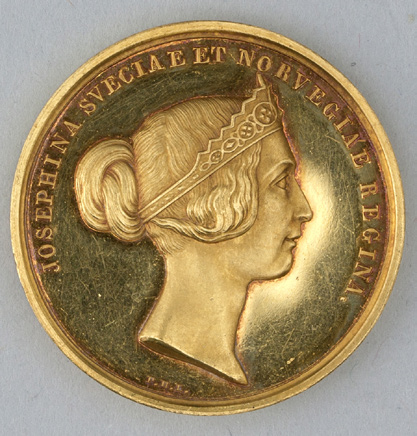
6304
Joseph Czapek’s medal
A round medal made of gold with a portrait of Queen Josefina on the obverse (front). On the reverse is the text “TESSERA MEMORIAE” which means “memory’s treasury”. The medal is 3.1 cm in diameter.
The medal was awarded to music director Joseph Czapek, probably in the 1850s. Czapek (1825–1915) was born in what is now the Czech Republic. He was recruited to Sweden in 1848 because he was a very skilled musician. Among other places, he worked as music director of the Royal Götaland Artillery Regiment in Gothenburg. He was a much-appreciated musician and composer and received several commissions for compositions from the Swedish royal court.
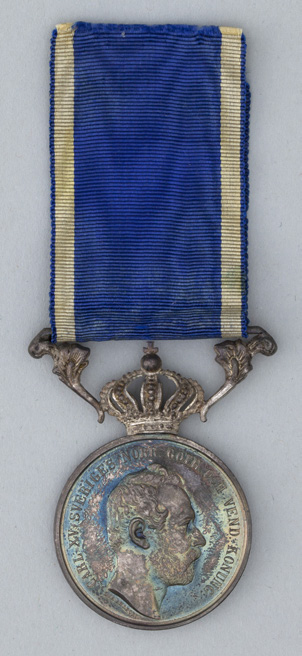
6305
Johan Hansson’s medal
A round medal made of silver with King Karl XV’s (Charles XV’s) portrait on the obverse (front). It has a blue silk ribbon with yellow edging. On the reverse is the medal’s motto around the edge in a circle: “Zeal and integrity in the service of the state”. In the centre are the recipient’s title and name. The medal is 3.1 cm in diameter.
The medal was awarded to postilion (i.e. mail carrier) Johan Hansson some time between 1863 and 1872. It was worn on the left side of the chest at the height of the breast pocket.

6306
Per Olof Wahlund’s medal
A round medal made of silver with King Karl XV’s (Charles XV’s) portrait on the obverse (front) and a ring at the top. The reverse is smooth with a Swedish inscription in several lines which says: “From King Karl XV to Per Olof Wahlund for 20 years’ devoted service as a Chief Guard at Stockholm Palace, 1868.” The medal is 3.1 cm in diameter.
It was worn on the left side of the chest, with a dark blue ribbon.

6307
Carl Johan Trolle’s medal
A round medal made of gold with a small royal crown on the top edge. The obverse (front) features the portrait of King Karl XV (Charles XV). On the reverse is the medal’s Latin motto “Illis Quorum Meruere Labores”, which means approximately: “For the person who has done something good and therefore deserves this”. The recipient’s title and name are also there. The medal is 3.1 cm in diameter.
The medal was awarded in 1863 to a chief superintendent called Carl Johan Trolle. The medal was worn on the left side of the chest, with a mid-blue ribbon with yellow edging.
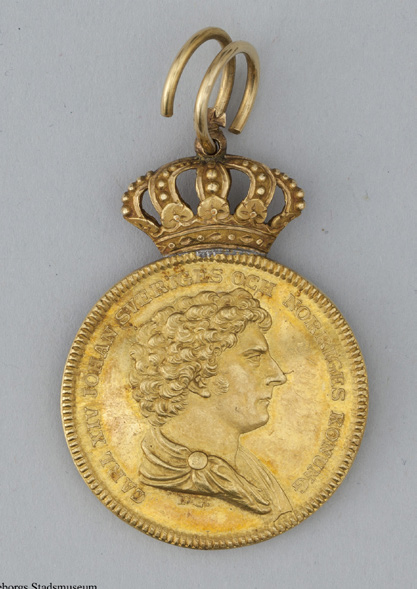
6308
Gustaf Melin’s medal
A round medal made of gold with a small royal crown on the top edge. The obverse (front) features the portrait of King Karl XIV Johan (Charles XIV John). On the reverse is a phoenix rising from the ashes plus the text “For Citizenly zeal”. The medal is 3.1 cm in diameter.
The medal was called “The award medal of the board of directors of the General fire insurance company” (Allmänna brandförsäkringsdirektionen). It was awarded to Gustaf Melin after the fire of Stigberget in 1821 when he saved many lives. His legs were so badly damaged in the fire that he never recovered.
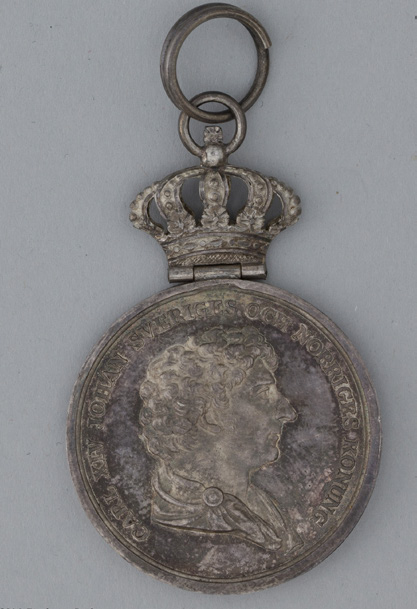
6309
Eric Jansson’s medal
A round medal made of silver intended to be worn around the neck. The obverse (front) features the portrait of King Karl XIV Johan (Charles XIV John). The medal is 3.7 cm in diameter.
On the reverse is a Swedish text which says: “The Royal County of Västmanland’s Agricultural Society award medal to Eric Jansson in Ersbo for diligence and industriousness in cultivation”. Jansson therefore received the medal because he was such a skilled grower, probably in the 1820s.

6310
Spinning medal
A round award medal made of silver from 1761. The obverse (front) features the portraits of King Adolf Fredrik and Queen Lovisa Ulrika. The reverse depicts a woman in a cottage room who is sitting, using a spinning wheel. Around the edge of the medal is a Swedish text which means: “To honour the woman who can spin quickly and skilfully.” The medal is 3.3 cm in diameter.
The medal is designed to be worn on a silver chain, probably around the neck. The women who came from farms liked to wear their medals to church every Sunday. The medals therefore needed to be polished often, which can be seen from the often worn state of the surviving medals.
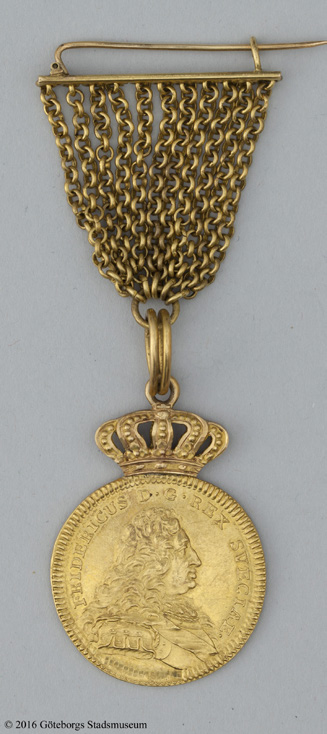
6311
Commemorative Seraphim Medal
A round medal made of gold. On the obverse (front) of the medal is the portrait of King Fredrik I. Around the edge of the reverse is the Latin text “PROCERES CUM PRINCIPE NECTIT”, which means “It unites the Peers with the King”. In the middle, inside the collar of the Order of the Seraphim, is a Latin text which says “Order of the Seraphim restored on the seventy-third birthday of the King”. The medal is 3.1 cm in diameter.
The medal was created to commemorate the founding of the Royal Order of the Seraphim on 17 April 1748. As of 1 January 1975 it is awarded by the King for outstanding services of a humanitarian nature or of general benefit to society.
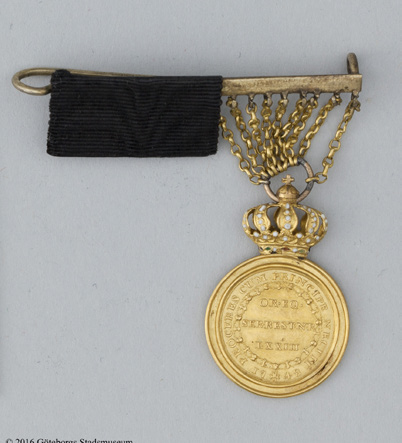
6312
Lars Montén’s medal
A round medal made of gold which is about 5 cm in diameter. The obverse (front) features the portrait of King Fredrik I. Here we can read the Latin text which says “Order of the Seraphim restored on the seventy-third birthday of the King”. The medal was created to commemorate the founding of the Royal Order of the Seraphim. This type of medal is the finest medal which the Swedish king can award.
This particular example hangs on chains from a clasp and is said to have been worn by a wholesale merchant called Lars Montén.

6313
Fredrikshamn
medal
An oval medal made of gold with a loop at the top for hanging. The obverse (front) features a goddess of victory wearing fluttering draperies and holding a laurel wreath in each hand. She is standing at the bow of a captured Russian ship with a Swedish flag. The struck Russian war flag is lying on the ship. To “strike a flag” means to surrender. On the reverse is the text: “40 ENEMY SHIPS CAPTURED ON 15 MAY 1790.” The medal is 3.2 cm wide and 6 cm high.
The medal is caller “the greater Fredrikshamn medal” and was awarded for bravery to regimental officers after the Swedish naval victory over the Russians off Fredrikshamn on 15 May 1790. It is worn on a double gold chain around the neck.
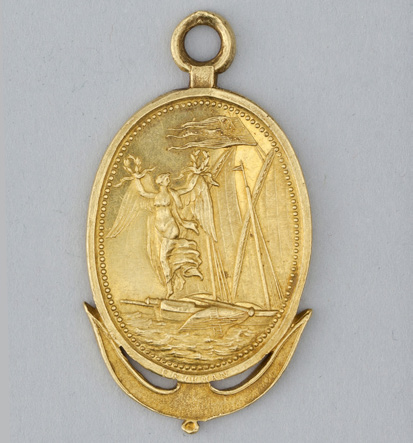
6314
Svensksund
medal
An oval medal made of gold with a loop at the top for hanging. The medal is 2.1 cm wide and 4.1 cm high. The obverse (front) features a goddess of victory wearing fluttering draperies and holding a laurel wreath in each hand. She is standing at the bow of a captured Russian ship with a Swedish flag. The struck Russian war flag is lying on the ship. To “strike a flag” means to surrender. On the reverse is the text “53 ENEMY SHIPS CAPTURED ON 15 MAY AND 53 ON 9 JULY 1790.”
The medal is called “the lesser Svensksund medal” and was awarded for bravery to Lieutenant J J Brusewitz (1768–1842). The Battle of Svensksund was a naval battle fought in 1790 at which the Swedes dealt the Russians a devastating defeat that resulted in an end to the Russo-Swedish War of 1788–90. The battle is the biggest Swedish naval victory and the largest naval battle ever in the Baltic Sea.

6315
Godparent insignia
An oval medal made of gold. In the centre is the portrait of King Gustav III framed by a laurel wreath. On the reverse is a Swedish text which says: “Given by King Gustaf III to Speaker of the Burger Estate of Sweden Carl Fr. Ekeman, Godparent to Crown Prince Gustaf Adolph of Sweden, 10 November 1778”. The medal is 4.6 cm wide and 6.2 cm high.
Godparent insignias were presented at christenings.
This particular godparent insignia was given to Carl Fredrik Ekeman, Speaker of the Burger Estate of Sweden (the Estates of Sweden were an early form of parliament), when Crown Prince Gustav Adolf was christened in Stockholm Cathedral in 1778. Godparent insignia varied in appearance depending on the social rank of the recipient.
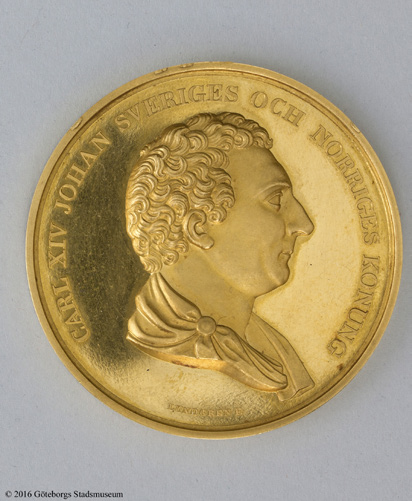
6316
Medal made of gold for citizenly virtue
A round medal made of gold. The obverse (front) features the portrait of King Karl XIV Johan. On the reverse is the text “FOR CITIZENLY VIRTUE” inside a laurel wreath. The medal is 5.6 cm in diameter.
The medal was awarded to British citizen D. Fraser in Motala in 1834 for manufacturing the engines of the Swedish Navy’s first steamship, the Gylfe. The medal is intended to be kept rather than worn by its recipient.
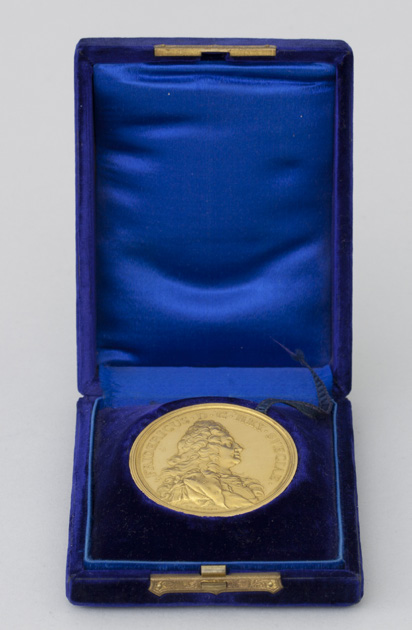
6317
Commemorative medal in box
A round medal made of gold. The obverse (front) features the portrait of King Fredrik I. On the reverse are images of various tools including a sledgehammer and tongs. The medal was originally made to commemorate “Jernkontoret’s obtained privileges” in 1747 (Jernkontoret is the industry organisation of the Swedish iron and steel industry). This particular example was probably made in the 1860s.
The commemorative medal was awarded to municipal politician Carl Fredrik Waern. It is stored in a box lined with blue velvet. On the lid are the initials C. F. W. printed in gold.
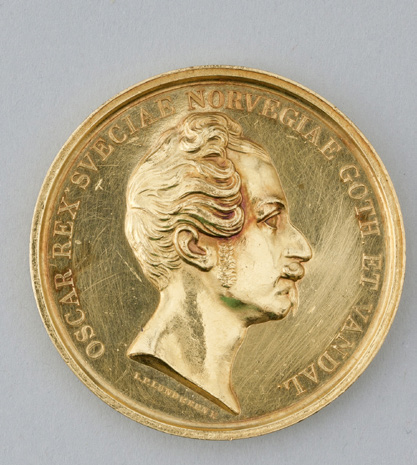
6318
Joseph Czapek’s individual medal
A round medal made of gold. The obverse features the portrait of King Oscar I with the text “commemorative medal” in Latin inside a laurel wreath. Around the edge is the recipient’s name and title in Latin: “Josepho Czapek. Musices Directori.” The medal is 4.3 cm in diameter.
The medal was awarded to music director Joseph Czapek, probably in the 1850s. The medal is intended to be kept rather than worn by its recipient.
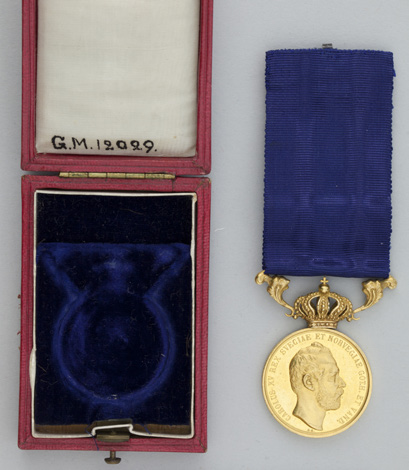
6319
Joseph Czapek’s Litteris et Artibus medal
A round medal made of gold. On the obverse (front) is a portrait of King Karl XV (Charles XV). On the reverse is the Latin text “Litteris et Artibus”, which means “For literature and the arts”. The medal is awarded for outstanding service to the arts. This particular medal was awarded to music director Joseph Czapek in 1860.
The medal is 3.1 cm in diameter and hangs from a wide blue ribbon. Accompanying the medal is a red leather box with a purple velvet lining.